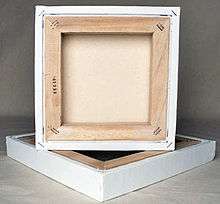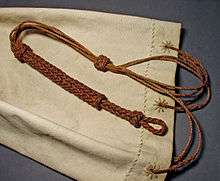Canvas


Canvas is an extremely durable plain-woven fabric used for making sails, tents, marquees, backpacks, and other items for which sturdiness is required. It is also popularly used by artists as a painting surface, typically stretched across a wooden frame. It is also used in such fashion objects as handbags, electronic device cases, and shoes.
Etymology
The word "canvas" is derived from the 13th century Anglo-French canevaz and the Old French canevas. Both may be derivatives of the Vulgar Latin cannapaceus for "made of hemp," originating from the Greek κάνναβις (cannabis).[1][2]
Physical characteristics
Modern canvas is usually made of cotton or linen; although, historically it was made from hemp. It differs from other heavy cotton fabrics, such as denim, in being plain weave rather than twill weave. Canvas comes in two basic types: plain and duck. The threads in duck canvas are more tightly woven. The term duck comes from the Dutch word for cloth, doek. In the United States, canvas is classified in two ways: by weight (ounces per square yard) and by a graded number system. The numbers run in reverse of the weight so a number 10 canvas is lighter than number 4.
For painting
Canvas has become the most common support medium for oil painting, replacing wooden panels. One of the earliest surviving oils on canvas is a French Madonna with angels from around 1410 in the Gemäldegalerie, Berlin. However, panel painting remained more common until the 16th century in Italy and the 17th century in Northern Europe. Mantegna and Venetian artists were among those leading the change; Venetian sail canvas was readily available and regarded as the best quality.
Canvas is typically stretched across a wooden frame called a stretcher and may be coated with gesso before it is to be used; this is to prevent oil paint from coming into direct contact with the canvas fibres, which will eventually cause the canvas to decay. A traditional and flexible chalk gesso is composed of lead carbonate and linseed oil, applied over a rabbit skin glue ground; a variation using titanium white pigment and calcium carbonate is rather brittle and susceptible to cracking. As lead-based paint is poisonous, care has to be taken in using it. Various alternative and more flexible canvas primers are commercially available, the most popular being a synthetic latex paint composed of titanium dioxide and calcium carbonate, bound with a thermo-plastic emulsion. Many artists have painted onto unprimed canvas, such as Jackson Pollock,[4] Kenneth Noland, Francis Bacon, Helen Frankenthaler, Dan Christensen, Larry Zox, Ronnie Landfield, Color Field painters, Lyrical Abstractionists and others.
Early canvas was made of linen, a sturdy brownish fabric of considerable strength. Linen is particularly suitable for the use of oil paint. In the early 20th century, cotton canvas, often referred to as "cotton duck," came into use. Linen is composed of higher quality material, and remains popular with many professional artists, especially those who work with oil paint. Cotton duck, which stretches more fully and has an even, mechanical weave, offers a more economical alternative. The advent of acrylic paint has greatly increased the popularity and use of cotton duck canvas. Linen and cotton derive from two entirely different plants, the flax plant and the cotton plant, respectively.
Gessoed canvases on stretchers are also available. They are available in a variety of weights: light-weight is about 4 oz (110 g) or 5 oz (140 g); medium-weight is about 7 oz (200 g) or 8 oz (230 g); heavy-weight is about 10 oz (280 g) or 12 oz (340 g). They are prepared with two or three coats of gesso and are ready for use straight away. Artists desiring greater control of their painting surface may add a coat or two of their preferred gesso. Professional artists who wish to work on canvas may prepare their own canvas in the traditional manner.
One of the most outstanding differences between modern painting techniques and those of the Flemish and Dutch Masters is in the preparation of the canvas. "Modern" techniques take advantage of both the canvas texture as well as those of the paint itself. Renaissance masters took extreme measures to ensure that none of the texture of the canvas came through. This required a painstaking, months-long process of layering the raw canvas with (usually) lead-white paint, then polishing the surface, and then repeating.[5] The final product had little resemblance to fabric, but instead had a glossy, enamel-like finish.
With a properly prepared canvas, the painter will find that each subsequent layer of color glides on in a "buttery" manner, and that with the proper consistency of application (fat over lean technique), a painting entirely devoid of brushstrokes can be achieved. A warm iron is applied over a piece of wet cotton to flatten the wrinkles.
Canvas can also be printed on using offset or specialist digital printers to create canvas prints. This process of digital inkjet printing is popularly referred to as Giclée. After printing, the canvas can be wrapped around a stretcher and displayed.
For embroidery
Canvas is a popular base fabric for embroidery such as cross-stitch and Berlin wool work.[6] Some specific types of embroidery canvases are Aida cloth (also called Java canvas[7]), Penelope canvas, Chess canvas, and Binca canvas.[8][9][10] Plastic canvas is a stiffer form of Binca canvas.[11]
As a compound agent
From the 13th century onward, canvas was used as a covering layer on Pavise shields. The canvas was applied to the wooden surface of the Pavise, covered with multiple layers of gesso and often richly painted in tempera technique. Finally, the surface was sealed with a transparent varnish. While the gessoed canvas was a perfect painting surface, the primary purpose of the canvas application may have been the strengthening of the wooden shield corpus in a manner similar to modern glass-reinforced plastic.
Splined canvas, stretched canvas and canvas boards
Splined canvases differ from traditional side-stapled canvas in that canvas is attached with a spline at the rear of the frame. This allows the artist to incorporate painted edges into the artwork itself without staples at the sides, and the artwork can be displayed without a frame. Splined canvas can be restretched by adjusting the spline.
Stapled canvases stay stretched tighter over a longer period of time, but are more difficult to re-stretch when the need arises.
Canvas boards are made of cardboard with canvas stretched over and glued to a cardboard backing, and sealed on the backside. The canvas is typically linen primed for a certain type of paint. They are primarily used by artists for quick studies.
Types
- Dyed canvas
- Fire-proof canvas
- Printed canvas
- Stripe canvas
- Water-resistant canvas
- Waterproof canvas
- Waxed canvas

Products

- Wood-and-Canvas canoes (see photo of canvas being stretched on a canoe)
- Canvas bags
- Coated Canvas bags (e.g. Goyard)
- Canvas covers
- Canvas shoes (e.g. Converse, Vans, Keds)
- Canvas tarpaulins
- Canvas tent (e.g. Armbruster Manufacturing Co.[12])
- Martial arts uniforms (e.g. Tokaido, Shureido, Judogi)
See also
References
| Wikimedia Commons has media related to Canvas. |
- ↑ "The Online Etymology Dictionary". Etymonline.com. Retrieved 2012-05-05.
- ↑ "Oxford Dictionaries". Oxford University Press. Retrieved 2014-03-01.
- ↑ "National Museum (Muzeum Narodowe)". www.warsawtour.pl. Retrieved 20 October 2013.
the largest Polish painting "Battle of Grunwald" by Jan Matejko (426 x 987 cm).
- ↑ "Jackson Pollock - A Life". Theblurb.com.au. 2002-10-04. Retrieved 2012-05-05.
- ↑ "Classical Oil Painting Technique". Cartage.org.lb. Archived from the original on 2012-03-01. Retrieved 2012-05-05.
- ↑ Cluckie, Linda (2008). The Rise and Fall of Art Needlework: Its Socio-Economic and Cultural Aspects. Arena. p. 60. ISBN 0955605571.
- ↑ Saward, Blanche C. (1887). Encyclopedia of Victorian needlework: Dictionary of needlework, Volume 1. Dover Publications.
Aida Canvas. — This material, introduced under the French name Toile Colbert, is a description of linen cloth. It is also called " Aida Cloth," and Java Canvas ( which see), as well as " Fancy Oatmeal."
- ↑ White, A.V. Primary Embroidery Stitches and Designs. Taylor & Francis.
- ↑ Bendure, Zelma & Gladys (1946). America's fabrics: origin and history, manufacture, characteristics and uses. Macmillan Company. p. 616.
- ↑ Morris, Barbara (2003). Victorian embroidery : an authoritative guide. Mineola, N.Y.: Dover Publications. p. 166. ISBN 0486426092.
- ↑ Goodridge, Paula (2009). Art activities : that are easy to prepare and that children will love. Bedfordshire, UK: Brilliant Pub. p. 65. ISBN 1905780338.
- ↑ http://armbrustertentmaker.com manufacturers website
External links
| Look up canvas in Wiktionary, the free dictionary. |
| Wikisource has the text of the 1911 Encyclopædia Britannica article Canvas. |


.svg.png)